Features
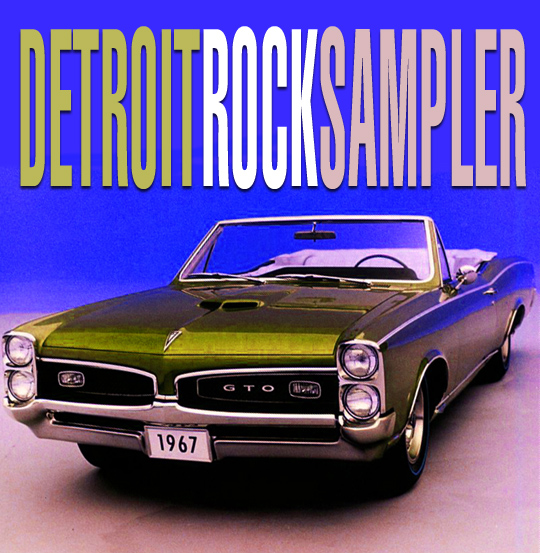
DETROITROCKSAMPLER was conceived by Julian Cope for the purposes of this review (1st November 2010ce)
- Rationals (1968) Guitar Army (3.18)
- MC5 (1970) Looking at You (3.05)
- Alice Cooper (1970) Long Way to Go (3.05)
- The Up (1970) Together (4.23)
- Amboy Dukes (1967) Journey to the Centre of the Mind (3.14)
- Don & the Wanderers (1968) On the Road (2.18)
- Bob Seger System (1967) Heavy Music (2.39)
- Mynah Birds (1967) I’ve Got You in My Soul (2.29)
- Third Power (1970) Persecution (3.25)
- Detroit (1971) Rock’n’roll (5.53)
- Grand Funk Railroad (1969) Inside Looking Out (9.32)
- Pleasure Seekers (1966) What a Way to Die (2.14)
- Unrelated Segments (1967) Story of My Life (2.38)
- Terry Knight & the Pack (1967) How Much More? (2.30)
- Woolies (1966) Who Do You Love? (2.00)
- Underdogs (1967) Love’s Gone Bad (2.27)
- SRC (1968) Black Sheep (3.47)
- Flaming Ember (1967) Gotta Get Away (4.20)
- Frigid Pink (1970) House of the Rising Sun (4.39)
- Stooges (1970) Down on the Street (2.47)
- Savage Grace (1971) All Along the Watchtower (5.41)
- The Frost (1971) Rock’n’roll Music (3.00)
- MC5 (1968) Borderline (3.11)
- Funkadelic (1973) Cosmic Slop (3.21)
- Wayne Kramer (1975) Get Some (3.38)
- The New Order (1975) Declaration of War (2.48)
- Ascension (1973) Get Ready (8.54)
- Destroy All Monsters (1977) You’re Gonna Die (2.52)
- Sonic’s Rendezvous Band (1977) City Slang (5.15)
- Southbound Freeway (1967) Psychedelic Used Car Lot Blues (2.30)
- Bob Seger System (1967) 2+2 (2.45)
- Unrelated Segments (1967) Where You Gonna Go?
- Terry Knight & the Pack (1966) Numbers (2.08)
- Tidal Waves (1966) Farmer John (2.09)
- The Früt (1971) Keep On Truckin’ (2.56)
- ? & the Mysterians (1966) Girl (2.18)
- Iguanas (1965) Mona (2.39)
- Stooges (1969) Asthma Attack (6.36)
Note: Just wanted to warn you in advance that there ain’t no chronology to this tracklisting, just an avalanche of burning devils music. I figured I was obliged to commence with the Rationals’ ‘Guitar Army’ on account of its John Sinclair connection and to conclude with the Stooges’ ‘Asthma Attack’– Iggy’s homage to Kim Fowley’s expectorating – because only the dutiful would be left standing at tape’s end.
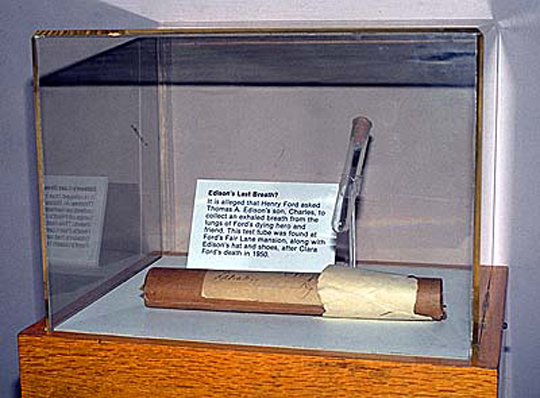
The last breath of Thomas Edison, nowadays on display in the museum of his disciple Henry Ford.
Avebury, Mecca, Jerusalem, Rome, Detroit
Detroit, Michigan, was the epicentre of 20th Century Western Culture, a sacred navel in whose lakeside bosom dwelt the two greatest prophets of their time: the electric light-bringing Thomas Edison – whose company General Electric remains to this day the largest in the world – and Henry Ford, whose percipient prophecy – “I will make a motorcar for the multitude [to] enjoy hours of pleasure in God’s great open spaces” – would later be realised in Ford’s legendary Model T. “I’m going to democratize the automobile,” declared Ford early on, though his original intention of bringing forth only eco-friendly hemp-fuelled automobiles (to be built on his father’s vast hemp farm) would soon be dashed by the unrighteous drive of business rivals and cynical partners. But however tragically the rise of the Car Industry has turned out for we Moderns, let us always remember how H. Ford’s visionary ideas freed working men and women of the early 20th Century – at least temporarily – from the mind-numbing drudgery of their daily grind upon the land. Created on a mechanical assembly line, the revolutionary Model T reinforced those hoary Puritan values of self-reliance that America’s first white arrivals had brought with them to Plymouth Rock, encouraging other car-makers across America to move their auto shops to Detroit, Michigan. And if it is true, as C. G. Jung attests, that a culture’s greatest interests are most evident from the roles of those buildings that dominate its horizons, then the sky-hugging auto factories of Detroit might well be classed as the cathedrals of this brand new secular age.
During World War 2, however, most of the Detroit auto industry was temporarily given over to the building of tanks and warplanes, and it was not until 1948 that the big three corporations – Ford, Chrysler and General Motors – unveiled their first postwar automobiles. But what automobiles they were! Themselves desperate to shrug off the olive drab and khaki nightmares of wartime, the car industry moguls rewarded the American public by unleashing upon them highly exotic new products more in keeping with the chariots of Ancient Rome. Big independent car companies brought forth futuristic chromium steeds with warplane-inspired names such as the Hudson Jet and Nash Airflyte, while new Studebakers even arrived replete with a non-functional propeller boss slap bang in the centre of their bullet-styled facades. Over at General Motors, chief designer Harley Earl went several airmiles further by adding missile-shaped hood ornaments to his first postwar Oldsmobiles, bombsight-style hood ornaments and lighting-up portholes to Buick’s upmarket Roadmaster series, and – inspired by the USAF’s P-38 Lightning fighter – even fashioned miniature tailfins upon his top-of-the-range Cadillacs. “Go all the way, and then back off”, was Harley Earl’s enlightened motto.
Electrifying Edisonian rock’n’roll
Its landscapes and cities untouched by the carpet-bombing which had shattered Europe and Japan, triumphant postwar America remained splendidly intact: the sole capitalist culture genuinely worthy of eulogizing in poetry and song. So although Oldsmobile founder Randsom E. Olds was an old-fashioned racist who insisted that whites alone be allowed to build cars in his Lansing factory, it was to Oldsmobile’s brand new supercharged ‘Rocket 88’ that Afro-American singer Jackie Brenston turned for his subject matter. Recorded in March 1951, ‘Rocket 88’ is nowadays generally regarded as the first true rock’n’roll song. However, despite its unfair Chess Records credit to the invented ‘Jackie Brenston & his Delta Cats’, the song’s rhythms were in truth laid down by Ike Turner’s Kings of Rhythm, with whom Brenston was merely the sax player. Ho-hum. But this record WAS rock’n’roll, and highly barbarian it was too: propelled along through a broken distorted amplifier by Ike’s insistent, urgent solid-body ice-blue Fender electric guitar. Like the car industry, rock’n’roll existed only because of huge advances in 20th Century technology. And whereas jazz could have survived the non-invention of Adolf Sax’s 19th Century saxophone, the beautiful ice blue Fender Stratocaster belonging to proto-rocker Ike Turner would, without the prophet Thomas Edison, have been no more than an ultra moderne lump-of-wood. But although white society would initially dismiss such outbursts such as ‘Rocket 88’ as ‘the Devil’s Music’, the song’s patriotic subject matter – being a product made in Detroit by the US auto industry – forged an unbreakable link between the new electric music and fast cars. It was true that jazz too had long eulogized car culture. But the future was electric. And from here on in, jazz would be caught on the backfoot, constantly fending off the ‘old timer’ tag on account of its acoustic nature. Henceforth – to bastardize the words of Duke Ellington’s 1943 jazz hit – “It don’t mean a piss if it ain’t got that hiss.” Now, c’mon!
Diss Integration in the Motor City!
Although the feisty youth music celebrated within the grooves of this here DETROITROCKSAMPLER was mostly made by Detroit area musicians of a Caucasian or Latino background, musicologists have long emphasized the particularly strong Afro-American influence of soul music, gospel and R&B upon the Detroit rock scene due to the enduring presence of Berry Gordy’s Tamla Motown empire. So it comes as a shock to discover that local government agencies in Detroit, far from operating integrated and enlightened race policies ahead of other northern cities, had long chosen to keep black and white communities steadfastly apart, citing the events of the city’s first Race Riot of 1863 as their excuse. Thereafter, Detroit’s rising Afro-American population regularly complained of their lack of job opportunities, police brutality and experiences of housing discrimination. During World War 2, however, Detroit’s racist employment policies were forcibly lifted – albeit temporarily – by Franklin Roosevelt’s Fair Employment Practices Committee, luring a further 50,000 Afro-Americans, mainly from the Deep South, to seek employment at one of Michigan’s multitude of aircraft and tank factories. But the second Race Riot of 1943 revealed deep-seated and institutional racist practices, not least the fact that 85% of those rioters arrested had been black. And it was the continuance of these nefarious racist practices through the ‘50s into the early ‘60s to which the black activist Malcolm X referred when he commented in his 1965 autobiography: “The truth is that ‘integration’ is an image, it’s a foxy Northern liberal’s smoke-screen that confuses the true wants of the American black man.” Continuing his tirade elsewhere, X concluded: “I know nothing of the South. I am a creation of the Northern white man and of his hypocritical attitude towards the Negro. “
But the Civil Rights era was by now upon us, and Afro-American leaders seized their opportunities like never before. Whitney Young transformed the traditionally conservative National Urban League into a radical organisation, using his position as executive director to goad corporations into hiring more and more Afro-Americans. In Detroit, Young even befriended Ford Motor Company’s new boss, Henry Ford II, promising the industrialist in 1966 that – should he help promote integration for Detroit’s heavy industry – Young’s PR machine would ensure that Ford would be perceived as ‘the White Moses’. But the following year, Detroit’s third set of Race Riots broke out during heavy-handed policing one hot July ’67 night. And it’s from the poetic heart of this powder keg, this city of perpetual race problems and heavy industry that all of the music on DETROITROCKSAMPLER was brought forth, Detroit’s apartheid practices and its ambivalence, nay, antipathy towards racial integration surely contributing hugely to the extraordinarily heaviness of even the poppiest songs contained herein. Wayne Kramer of the MC5 has described the enormous status enjoyed by Tamla Motown’s musicians among his own peers – ‘Play like [James] Jamerson’, he always urged the Five’s Michael Davis. But even to a hip white insider such as Kramer these Tamla guys were remote figures from another world. So listen now to the music of DETROITROCKSAMPLER, and hopefully the city’s own unique worldview will – as you read the thirty-eight song reviews – unfold before your melted plastic brains. Dig in, motherfuckers!
The Song Reviews
1. Rationals – Guitar Army (Genesis Records 1969)
Despite lending its name to White Panther poet/guru John Sinclair’s classic 1971 book of prison and street writings, this Rationals opening salvo – exhilarating, futuristic and psychedelic as it was – had only the outward appearance of being the soundtrack to Detroit revolution. In truth, singer Scott Morgan admitted: “I ain’t talking about burning it down, I’m just talking about getting down.” Ho-hum. Still, for all yew kiddies who know next to nothing of the Rationals, I gots to tell you that by the release of their ‘Guitar Army’ 45, this quartet had progressed in leaps and bounds since their mid-60s beginnings delivering white soul 7” covers of Aretha’s ‘Respect’. Moreover, leader Scott Morgan would co-lead Fred ‘Sonic’ Smith’s late-70s Sonic’s Rendezvous Band; evidence indeed of his Heavy Rep among those motherfuckers in Da Know. Unfortunately, the accompanying 1969 self-titled LP could in no way sustain the burning desires of the single, which occupies a rare & blissful space somewhere between power-trio period Mark, Mel & Don and the more tight-ass studio soul moments of the MC5’s patchy KACK IN THE USA, that is if it hadn’t been ‘produced’ into the abortion clinic by Bruce Springclean’s corpulent middlebrow manager-to-be. Know-worrameen?
2. MC5 – Looking at You (A-Square 1968)
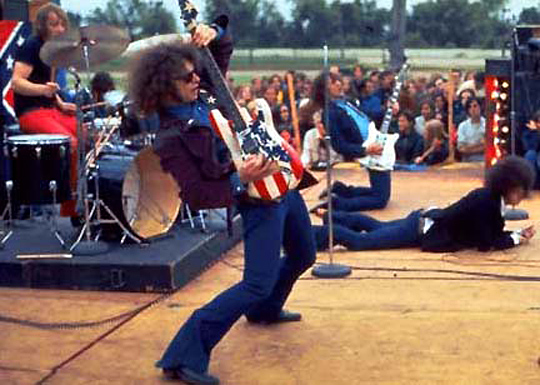
MC5
3. Alice Cooper – Long Way to Go (Warner Bros 1971)
Free at last from their merely tiresome too-Frank Zappa-influenced Straight Records period, Arizona’s heavy quintet Alice Cooper took up residence in their spiritual home of Detroit, hired Toronto Bob Ezrin as producer and set about subsuming the MC5’s entire oeuvre into their next LP LOVE IT TO DEATH. Herein, hunky main songwriter Michael Bruce barfed out this Fivean teen anthem, while ghoul-eyed Dennis Dunnaway stole the entire show with his pulsing basslines, and Toronto Bob did his best to capsize the fucker with a well-twee Joanna-boogie middle-8. Canadians, Sheesh! Later that year, Detroit’s Channel 28 had the pleasure of presenting Vince’n’Co performing an elongated versh of LOVE IT TO DEATH’s lyrically perplexing ‘Is It My Body’, during which Herr Furnier AKA Alice His-self stripped down to the kind of odd disgusting grundies that even senile old biddies would baulk at. I know. When I played said performance at the climax of DISCOVER ODIN, my 2001CE British Museum festival, several walked out and a few complained. Nevertheless, before he nicked his band’s name for his own persona and tried to sell us that rancid top-hatted Nightmare Welcomer-period, old V. Furnier was a right Vincebus Eruptum.
4. The Up – Together (1970)
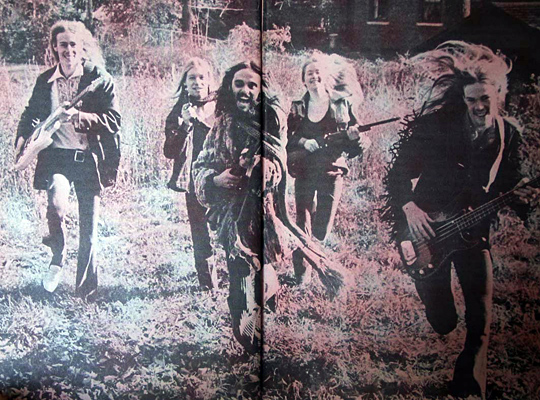
The Up
5. Amboy Dukes – Journey to the Centre of the Mind (Mainstream 1968)
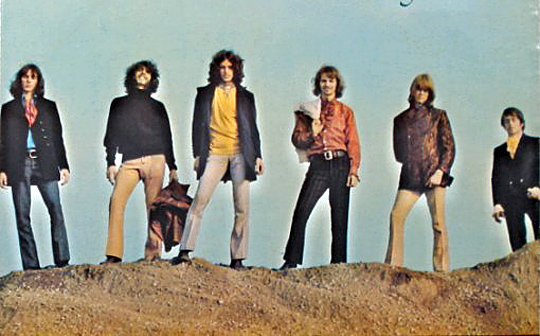
Amboy Dukes
6. Don & the Wanderers – On the Road (Kustom Records 1968)
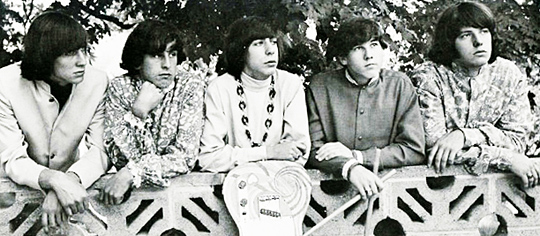
Don & The Wanderers
7. Bob Seger & the Last Heard – Heavy Music (Capitol 1967)
Yeah yeah punks, I know yooz all wondering why Boring Bob AKA Snoring Seger lifted Tommy James & the Shondells’ ‘Mony Mony’ for the basis of this superb A-side. But as ‘Mony Mony’ didn’t appear until almost a full year later – mid-1968 – Tommy James was obviously smokescreening furiously when he commented: “Songs like ‘Mony Mony’ aren’t really written, they’re sort of hanging in space”. Yeah right, ‘aren’t really written by me’ is what James was trying to avoid saying LOL. Anyway, by utilising a superb piano/bass guitar riff as the vehicle on which to build his workout, and employing an occasional stop-start lifted directly from the Music Machine’s ‘Talk Talk’, Bob Seger created this vast ‘song-about-the-song’ that was intended to transport listeners ‘deeper’ into the music than ever before. “Don’t you ever feel like going insane when the drums begin to pound?” wails Seger, as the tension mounts and the vocal collective support James Brown-style the singer’s every emotion. And all the time the ‘heavy music’ – somewhere midway between the all-purpose Cannibal & the Headhunters party clatter of the Strangeloves and the pomp of P. Spector – drags us further and further into that grey area between dancing and fucking. ‘Deeper, deeper’ hectors our hero to his girl, to his band and to his radio audience, until – like Cheech & Chong’s Basketball Jones – he’s calling out across the whole fucking world and all future copies sound merely ‘Phoney phoney’. Yowzah!
8. Mynah Birds – I’ve Got You In My Soul (1966 Motown demo)
Who knows what greatness might have been achieved at Tamla Motown had this unstable and integrated proto-supergroup not exploded in a fit of draft board and work permit problems? Still, despite being relegated to no more than one of rock’n’roll’s Mythical Near-Misses, the temporary union of vocalist Rick ‘Super Freak’ James with Neil ‘Shakey’ Young and future Buffalo Springfield bassist/guru Bruce Palmer inevitably stuffs the head of any Utopian music obsessive with wall-to-wall ‘what ifs’, especially when the funky contents of ‘I’ve Got You In My Soul’ are trotted out as evidence. Shit, this is good: the vocal delivery, Young’s harmonica, that compelling groove, and most especially Van Morrison’s magnificent song. Recorded in February ’66 at Motown’s Detroit studio on West Grand Boulevard, ‘I’ve Got You in My Soul’ was intended for inclusion on the Mynah Birds’ debut LP – the first of a seven-year-contact allegedly – that is, until the untimely arrest of singer James by US Navy police for desertion. However, bassist Bruce Palmer does at least provide us with one unforgettable image of this lost supergroup at the height of their stage performances:
“Neil would stop playing lead, do a harp solo, throw the harmonica way up into the air and Ricky would catch it and continue the solo.”
9. Third Power – Persecution (Vanguard Records 1970)
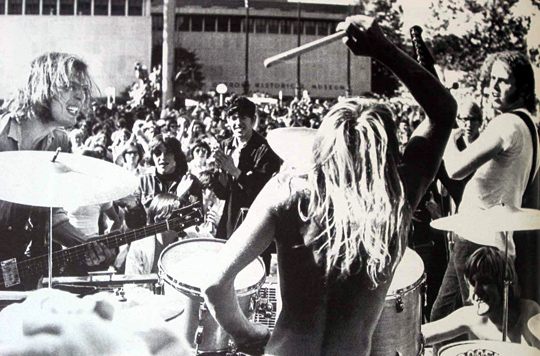
Third Power
10. Detroit – Rock’n’roll (Paramount 1971)
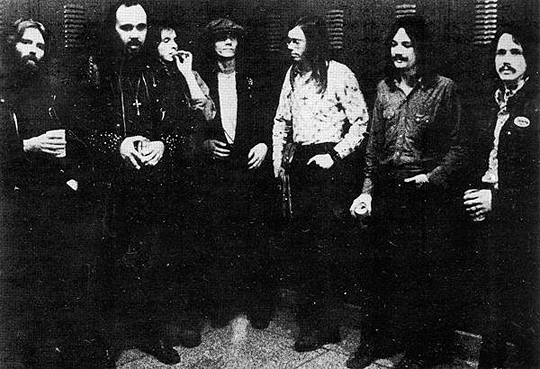
Detroit
11. Grand Funk Railroad – Inside Looking Out (Capitol Records 1969)
Disparaged by the contemporary music press for (1) their refusal to give interviews, (2) their naïve trust in mentor/producer Terry Knight, and (3) singer/guitarist Mark Farner’s obstinately heroic Apache Jock image, it’s only by adopting 20/20 Hindsight and employing a 21st Century open mindset of Anglican proportions that we’re forced to certain obvious conclusions: Fuck me, they was good! Yup, all those mid-60s years spent backing up then-singer Terry Knight meant an almost total absence of the then-prevalent guitar drywank – Cream’s noodling, the albatross blues of Ten Years After’s Alvin Lee, J. Page’s violin bow mucking about, oh you name it – Grand Funk substituting instead seemingly endless R&B grooves deployed with all the caveman subtlety of the Japanese army during the Rape of Nanking. That their (arguably) finest moment was achieved on this Animals cover versh is not a comment on Grand Funk’s inability to write great songs, neither; hell, this classy tune has long been the flagship of such other greats as the Obsessed and Tight Bros From Way Back When. But what draws rock nutters back again and again and again to this 9-minute behemoth is the sheer exhilaration created by Mark, Mel & Don’s incredible power-drives. It’s as though they were performing extracts from twenty classic soul stompers, reducing each to the bite-size highpoints required for the nowadays obsolete artform known as ‘the Medley’. Yup kiddies, listen to Grand Funk Railroad as though each song was a performance of several medleys and your worldview opens up before you. Indeed, what you’d previously dismissed as Heavy Metal Overkill actually becomes soul music as played by the USAF!
12. Pleasure Seekers – What a Way to Die (Hideout 1966)
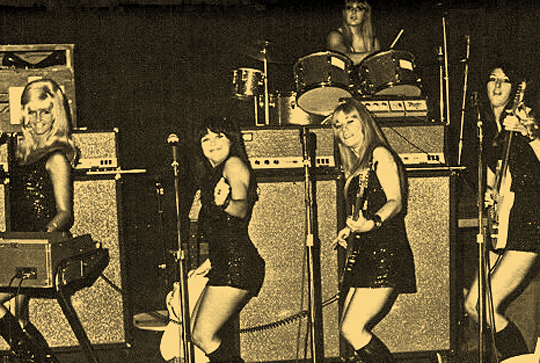
Pleasure Seekers
13. Unrelated Segments – Story of My Life (Hanna Barbera 1967)

Unrelated Segments
14. Terry Knight & the Pack – How Much More? (Lucky Eleven 1967)
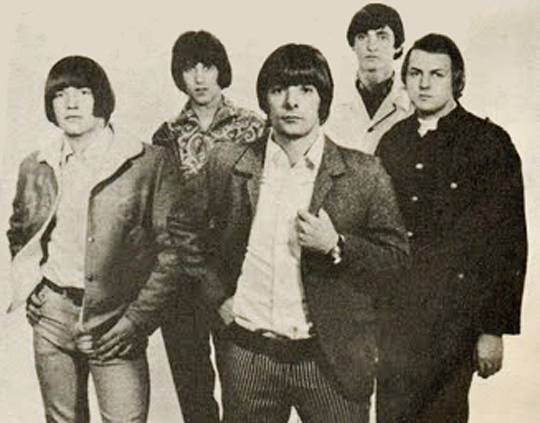
Terry Knight & the Pack
15. Woolies – Who Do You Love? (Dunhill Records 1967)
Winners of Vox Amplifiers’ 1966 ‘Best Band In The Land’ competition, the Dearborn-based Woolies were shocked to discover that their first prize of a record contract and a trip to Hollywood “turned out to be a big fraud”, as group leader Bob Baldori would later comment. Goaded by the Woolies’ threats of negative publicity, however, the Vox promoters at least agreed to pay for plane tickets to Los Angeles, where the five musicians hawked their 5-song demo tape around several labels before successfully wooing Lou Adler’s ABC-Dunhill label. Entering LA’s Western Sound Studios the following day, they nailed this stunning Bo Diddley cover and headed for home, where the record peaked at number 3 on WKNR’s prestigious MUSIC GUIDE. Heavy radio play in the Chicago area soon pushed the 45 into the national Top 100, where it unfortunately stalled at #95. Nevertheless, this glimpse of stardom increased the Woolies’ Detroit kudos so much that Chuck Berry requested them as backing band for all future Detroit shows and Russ Gibb invited them to support the MC5 on the Grande Ballroom’s second weekend.
16. Underdogs – Love’s Gone Bad (VIP Records 1966)
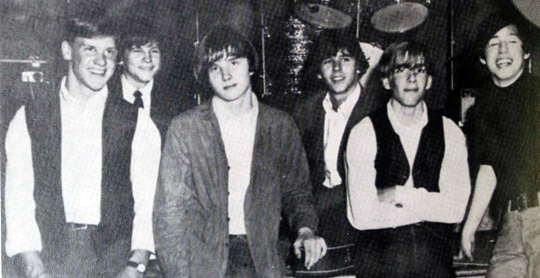
The Underdogs
17. SRC – Black Sheep (Capitol Records 1968)
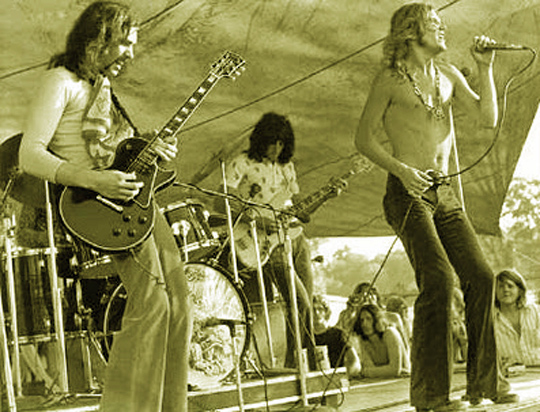
SRC
“Black sheep, outcast, misfit, Ishmael,
Every stranger each his own tale.”
Beginning his career as lead vocalist for the now-legendary Chosen Few at the prestigious opening of the Grande Ballroom, alongside guitarists Ron Asheton and James Williamson, SRC’s Scott Richardson was rightfully considered a hot ticket among Detroit’s hardest rockers. So it was to Richardson’s door that the hilariously-named Quackenbush brothers – organist Glenn and guitarist Gary – beat a path when they made their decision to split up their school band the Fugitives and get serious. Determined to secure full-time work, the new band was taken under the wing of legendary Michigan entrepreneur Jeep Holland, who – clearly mindful of the impact made by Britain’s Cliff Richard and Keith Richard AKA Keith Richards – shortened singer Scott’s surname and re-named the band The Scott Richard Case. Throughout the 68-70 period, Jeep Holland tirelessly pushed SRC as a Michigan-wide band but, even after signing an album deal with Capitol Records, no national success was forthcoming. And the reason? From what I’ve heard of SRC, too much of their music was so-so-a-go-go, too many of their songs merely unmemorable. And at a time when the word ‘Detroit’ equalled either tear-ass hi-energy rock or Tamla Motown classics, perhaps the reasonable sound and thoughtful songs of SRC let the band down. Ho-hum. So let’s instead remember this truly superb Detroit anthem to the underdog… nay, to the black sheep, motherfuckers!
18. Flaming Ember – Gotta Get Away (Ric Tic 1969)
Starting out in 1964 as the Flaming Embers, this white soul quartet spent half a decade aping black acts in an attempt to persuade Berry Gordy to sign them to Tamla Motown, but the closest they could get was when Motown bought out Ed Wingate’s Golden World and Ric Tic record labels, Flaming Ember getting included in the deal. The band finally achieved national success when 1969’s awful ‘Mind, Body and Soul’ peaked at #26 on the Billboard chart and the equally vapid ‘Westbound Number Nine’ hit the #15 slot, but are here represented by the beautiful gospel majesty of ‘Gotta Getaway’, a fairly G. Clintonesque mega-production worthy of early Funkadelic. Thereafter, Flaming Ember renamed themselves after their most well-known hit (‘Mind. Body and Soul’) and set about trawling the troughs of the chicken-in-a-basket scene. Ho-hum.
19. Frigid Pink (1970) – House of the Rising Sun (4.39)
Embarrassed that his band’s demo tape had failed to impress his girlfriend’s father Paul Cannon, then musical director of Detroit’s WKNR Radio, Frigid Pink drummer Richard Stevers was about to make his exit when a guitar blitz at the cassette’s end suddenly blasted out of nowhere: a colossally overdriven version of the Animals’ hoary anthem ‘House of the Rising Sun’. Perking up at last, Cannon insisted that it was a guaranteed monster hit. “But it’s already the b-side of our current single”, blurted Stevers. Then get your record company to flip the A-side, concluded Cannon. Within months, the song was a worldwide hit, four months in the UK Top 75, in Germany eleven weeks at number 1.
20. Stooges (1970) – Down on the Street (2.47)
In a somewhat pathetic attempt to get some radio play with a 7” single, Elektra persuaded former Kingsmen and then-current Stooges producer Don Galluci to add some classy keyboard to FUNHOUSE’s opening track. The Don having served up the Ur-business seven years previously on ‘Louie Louie’ itself, no right minder could then have expected Galluci to daub not frat-garage Uber-whumpf but hoary sub-sub-Doorsian Manzadrek all over his own hard work. That Galluci had no idea of the quality of the work he was undertaking with FUNHOUSE is strikingly evident from this shameless contribution to Lizard King Homage. But best of all, it combines with that moment in ‘TV Eye’ when the Ig screams ‘Brother, brother’ to showcase his Jimbo fixations most succinctly.
21. Savage Grace – All Along the Watchtower (Reprise Records 1971)
Just when you’re sure you don’t need another heavy versh of this Dylan monolith, along comes Savage Grace to demand, nay, command that you give’em a listen. And what a vast piece this is, kiddies; nearly six minutes of hi-energy De Twat overkill gets slung at Zimmerframe’s 3-lickle-chords and still its fabric remains buoyant and uncapsize-able. Bother. Still, Savage Grace was a mighty live stage ensemble, even said to have blown B. Sabbath offstage when supporting them at Michigan State Fairground, in summer ’71. Their records, however, were too eclectic for their own good, and a move to Los Angeles fucked their sound up even more. Back in the late ‘60s, bearded guitarist Ron Koss, piano player John Seanor and drummer Larry Zack had started out as a jazzy trio named Scarlet Letter, until gravel-chomping howler Al Jacquez joined them on bass and vocals, bringing a truly I. Gillan vocal transcendence to their oft too busy musicianship. Still, any band who coulda bullied this motherfucker on to magnetic tape has gotta be worth its own legend. Yowzah!
22. The Frost – Rock’n’roll Music (Vanguard Records 1969)
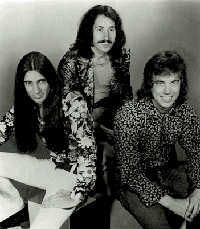
The Frost
23. MC5 – Borderline (Elektra Records 1969)
Supporting Blue Cheer at the Grande Ballroom on June 23rd 1968 appears to have generated such a seismic change in the musical approach of the pre-LP MC5 that Wayne & Co. briefly abandoned their R&B/soul roots in favour of ornately arranged Cumbersome Overkill in the style of Dickie, Leigh & Paul. That the Five were still immersed in OUTSIDEINSIDE is most evidenced both by their KICK OUT THE JAMS versions of the Troggs’ ‘I Want You’ and this magnificently brutal arrangement of their own ‘Borderline’, replete with ungainly stop-start Gatling gun drumming, proto-Mel Schacher Uber bass and note perfect harmony vocals. And although my first personal interface with the Five was my 1977 purchase of their bootleg Skydog Records 7” which contained an even MORE radical versh, I chose this timeless recording to best represent our fave Rock Revolutionaries because it was captured on the first day of the White Panther Party’s Zenta New Year AND badged with the Elektra Records seal of quality. Fuck Hudson’s, motherfuckers!
24. Funkadelic – Cosmic Slop (Westbound 1973)
Have a post-Malcolm X teenage Detroit power trio back up a psychedelicized New Jersey doo-wop outfit; how’s that gonna pan out? Hideous no doubt unless a World Genius such as George Clinton is the instigator behind it all. And despite having endured over a decade without chart success, songwriter and Parliaments leader Clinton held such enduring faith in his thirty-something cohorts Calvin Simon, Ray Davis, Grady Thomas and Fuzzy Haskins that he financed the band himself throughout the late ‘60s by gaining employment as a songwriter and staff producer at Tamla Motown, travelling home to New Jersey every weekend for shows with the Parliaments. However, when Detroit’s Revilot Records offered the Parliaments their own 7” single deal, only Clinton could afford to appear on the record, the rest being too broke to leave New Jersey. Desperate for money, Clinton signed Funkadelic to the Armen Boladian’s Westbound label and unleashed upon the world his post-Hendrix, post-Sly, post-Mothers of Invention vision and, lo… it was righteous, religious and its first 3LPs – FUNKADELIC (1970), FREE YOUR MIND & YOUR ASS WILL FOLLOW (1970) and MAGGOT BRAIN (1971) – all absurdly perfect. Unfortunately, the band thereafter abandoned its policy of presenting massively long, near-meditational grooves, dumping them in favour of more succinct songs. The fallow period which followed – 1972-73 -– yielded the politically-charged but musically tame AMERICA EATS ITS YOUNG double-LP, then the equally un-visionary COSMIC SLOP, whence came this epic Zappa-influenced title-track: released also as a Westbound Records 7”. Real George Clinton fanatics will not, I’m sure, find it strange that I should elect to represent Funkadelic with this song from one of their lesser LPs; for even their patchiest platters still brim over with vision and life-affirming invention. Besides kiddies, this song’s a funk Leviathan with Frank Zappa’s sense of humour, a World Serpent with a forked tongue in its cheek and a deadly sting in its 7-league-tail.
25. Wayne Kramer (1975) – Get Some (Stiff/Chiswick 1977)
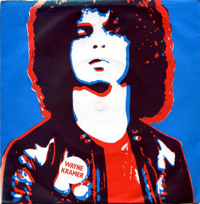
Wayne Kramer
26. The New Order – Declaration of War (Revenge Records 1976)
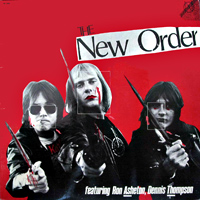
The New Order
27. Ascension – Get Ready (Recorded 1973)
Mindblown by the failure of the mighty MC5 yet forced by hunger to start out all over again, Five rhythm guitarist Fred ‘Sonic’ Smith and drummer Dennis ‘Machine Gun’ Thompson hooked up briefly with bassist John Hefti to form the mighty Ascension. With former MC5 bassist Michael Davis now singing lead, and expected by bar owners to play a large percentage of contemporary Top 40 hits, Ascension took full advantage of white funk band Rare Earth’s recent massive Top 40 re-work of the Temptations’ legendary ‘Get Ready’ to justify this their own killer 6-minutes-plus version. Grinding Rare Earth’s vacuous offering into the dust, Sonic’n’Co do Smokey Robinson’s entire Motown production with just guitars and overly-loud bass. It’s a wondrous blissful overkill, kiddies. Around five years ago, a full album of Ascension’s live set was available briefly from the always excellent Seidr label: search that sucker out! However, please do prepare yourselves in advance, all you Five fanatics, as it’s always difficult to hear an audience confront one’s heroes’ performances with a totally blank response.
28. Destroy All Monsters – You’re Gonna Die (Cherry Red 1977)
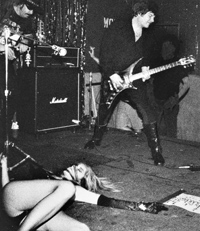
Destroy All Monsters
29. Sonic’s Rendezvous Band – City Slang (Limited Edition 1977)
Damn hard to accept that this exhausting and brilliant powerdrive was the sole contemporary vinyl release from this quartet of De Twat legends; it ain’t much evidence to go on, kiddies. Hell, even the b-side was just a mono versh of side one! And yet, this sole 1977 release by former members of the MC5, Rationals, Stooges and The Up contained all of the pent-up fury of 1971’s HIGH TIME as filtered through the Year Zero punk blender… and then some! And when the only other recourse to hearing Sonic’s Renzezvous back catalogue is via a multitude of iffy bootleg LPs, it’s great to know that this single showcased the band in a manner approved by its founders. So buy those bootlegs, sure, but do your utmost to seek out this official statement. For, despite being let down by lack of cash and real playing opportunities, Sonic’s Rendezvous Band was a Gnostic odyssey of epic proportions and a natural hi-energy successor to the Five’s HIGH TIME in all of its Sonic-heavy gloriosity. Jesus Fuck, this breaks my heart everytime.
30. Southbound Freeway – Psychedelic Used Car Lot Blues (Tera Shirma 1967)
Coming across on this record more San Francisco that Detroit, Southbound Freeway’s cranky folky sound was a direct product of lead guitarist Marc Chover, whose obsession with local folk singer Ted Lucas and his band the Spikedrivers1 pushed the Freeway into their vocal-heavy style and gained them many successful shows at Detroit’s folk club The Chessmate. The band’s big break, however, came with their invitation to open for the MC5 on one of the Grande Ballroom’s opening nights. Indeed, Southbound Freeway even appeared at the legendary (to some, infamous) Trans-Love Energies ‘love-in’ on Belle Isle, lining up alongside the MC5 and the Up. Thereafter, they entered Ralph Terrana’s tiny Tera Shirma studios, where they recorded ‘Psychedelic Used Car Lot Blues’ in one short night’s session. The single was a huge hit in Detroit after being picked up by CKLW Radio, enabling the band to play Robin Seymour’s hip teen TV show ‘Swingin’ ‘Time’. Syndicated re-runs even saw the single picked up by seven local record labels across the US, but still the song failed to break into the national Top 100.
31. Bob Seger System – 2+2=? (Capitol 1967)
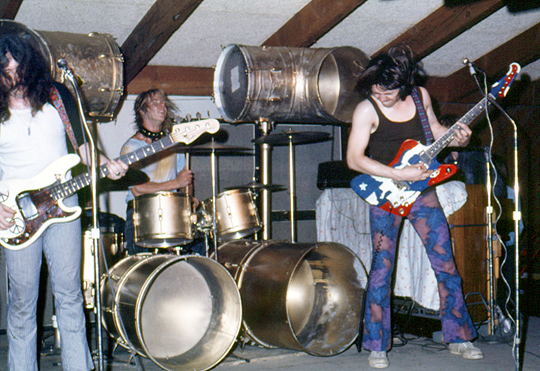
Bob Seeger System
32. Unrelated Segments – Where You Gonna Go? (Liberty Records 1967)
Despite failing nationally with their debut 45 ‘Story of My Life’, that song’s regional success opened the doors to Russ Gibb’s legendary Grande Ballroom, where the Unrelated Segments played supports to such major stars as the Who, the MC5, the Jeff Beck Group, Spirit and the Spencer Davis Group. Back into the studio for the recording of a second single entitled ‘Where You Gonna Go?’, guitarist Rory Mack this time unleashed a compelling Middle European riff that propelled the song with all the fire of a Cossack dance, over which bass player Barry Van Engelen overlaid an equally catchy percussive bass part, as though aping Brian Jones’ marimba on then-current Stones records. And again singer Ron Stults drooled out his epic teenage tale of abandonment and the coming perils of adulthood. And again, the Segments’ new single was a local smash, for a second time being picked up nationally, this time by Liberty Records. Unfortunately, the record stalled once more. And with the failure of this second 45, the third excellent single ‘Cry Cry Cry’ received only token publicity, this superb band folding for good when the drafted Van Engelen was sent to serve in Vietnam in early ‘69. Pah!
33. Terry Knight & the Pack – Numbers (Lucky Eleven 1966)
At least those poor suckers who bought a copy of Terry Knight’s excruciating ‘I Who Have Nothing’ 45 woulda been rewarded heftily by the inclusion of the mighty ‘Numbers’, its extraordinarily dynamic B-side. Hail, that bass/fuzz riff alone has just got to have been quarried from one of rock’s All Time granite seams, thereafter being fashioned by dwarfs into a solid bolt of forked lightning flung down from on high directly from the Fuzz Gods. Over this wriggling’n’pulsing Leviathan of a riff, Bad Tez gets mad at some little rich girl, piling up list upon list of her daily misdemeanours: too many motorcycles (7), too many phones (16), too many planes (12). Interesting lists in context with the killer riffery, but it ain’t exactly ‘Where Do You Go To, My Lovely?’, know worramean?
34. Tidal Waves – Farmer John (Hanna Barbera Records 1966)
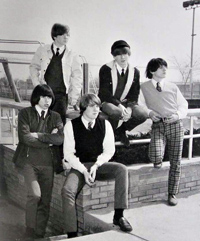
Tidal Waves
35. The Früt – Keep On Truckin’ (Westbound Records 1971)
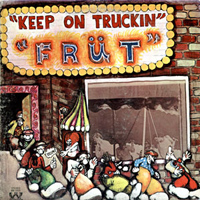
The Früt
36. ? & the Mysterians – Girl (Cameo Parkway 1967)
Tarred with the dreaded One Hit Wonder tag this band might be, but being in possession of such a song as ’96 Tears’? Well, who could need more? Besides, I spent time in summer ’77, at Birkenhead’s Zephyr Records buying up several of the Mysterians’ obscure Cameo Parkway 45s while hanging out in with my erstwhile neighbour Pete Burns (yup, he fucking adored PEBBLES-style garage music). All of the Mysterians’ singles were worth the price (25p) and their remarkable sameyness is still to this day only outperformed by that run of early 45s by Sky Saxon’s lunatic quartet the Seeds. Meanwhile, the Mysterians were all originally sons of Mexican migrants from Texas, rising to fame in the northern Detroit area of Saginaw, playing a pumping fusion of Texmex and James Brown to migrant farm workers. And so professional were the band that ’96 Tears’ sold over a million 7” singles, despite the band’s having been forced – through their record company’s lack of funds – into a studio with no headphones, no separate control booth, nor even a bass drum included as part of its session drumkit hire fee. Against all odds or what! Anyway, now please check out the Mysterians’ stubbornly futuristic ‘Girl’ and lament along with me that the public’s rapturous reception of their phenomenal US number one smash ensured that Americans would receive their Mysterians dosage in one large sitting, rather than over a course of several intriguing garage 45s. As Question Mark himself must have often thought: “Dammit!”
37. The Iguanas – Mona (1966)
Included herein more for musicological reasons than because this sucker’s good (eh, so-so-a-go-go I guess), this frat ensemble whence came Insurio Osterberg’s stage monicker might have stayed more legendary had they not committed it to tape. Still, we can – as we singalong to ‘Mona’ – consider Scott Morgan’s earnest pronouncement that his Rationals had considered offering Iggy the drum seat around ’68, then mull upon what the first Stooges LP coulda been, had not J. Cale been brown-nosing Holzman for a proper Elektra house producer job and forced upon those underachievers a spirited post-Troggsian teen LP utterly in opposition to that talked-up to biographers these past thirty years by Herr O his-self.
38. The Stooges – Asthma Attack (Elektra 1969)
Left off their John Cale-produced self-title LP debut and still unreleased to this day, the Stooges’ ‘Asthma Attack’ was Iggy’s spirited junior attempt to conjure up precisely that same expectorating madness that Grey Wizard Kimmy the Fowl had achieved effortlessly on his gloriously unhinged 1968 LP OUTRAGEOUS released just 10 months previously. Unfortunately, although L’Osterberg displays enough of an intimate knowledge of Fowley’s truly insane OUTRAGEOUS epics ‘Chinese Water Torture’ and ‘Nightrider’ to meld successfully the two into this giant Gob-a-thon, ‘Asthma Attack’ is not their equal simply because Iggy’s let down throughout by the reluctance of his fellow Stooges to abandon themselves to the primal scream states necessary for such an exercise. Which is a damn shame for the overall art state/ment (as J. Sinclair woulda spelled it), but ultimately still thrilling to observe Iggy both seeking AND finding inspiration in the throat-clearing of such a truly World Sleaze as His Kimmyness.

 DETROITROCK SAMPLER
DETROITROCK SAMPLER HARDROCK SAMPLER
HARDROCK SAMPLER Li Jianhong
Li Jianhong The Routes
The Routes Chairmen Of The Board
Chairmen Of The Board Evil Acidhead
Evil Acidhead Henry Wolff & Nancy Hennings
Henry Wolff & Nancy Hennings Silver Apples
Silver Apples OMD
OMD XTC
XTC Fleetwood Mac
Fleetwood Mac Fleetwood Mac
Fleetwood Mac Van Morrison
Van Morrison Vsevelodon the Bigot Nest (Vsevelod and the Big Nest)
Vsevelodon the Bigot Nest (Vsevelod and the Big Nest)